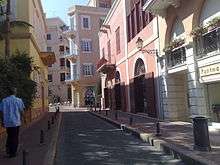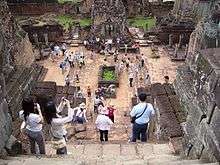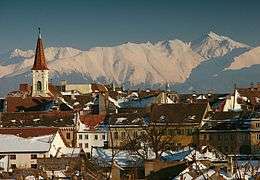Cultural tourism
Cultural tourism is the subset of tourism concerned with a traveler's engagement with a country or region's culture, specifically the lifestyle of the people in those geographical areas, the history of those people, their art, architecture, religion(s), and other elements that helped shape their way of life.
.jpg)


Overview
Cultural tourism includes tourism in urban areas, particularly historic or large cities and their cultural facilities such as museums and theatres.
It is generally agreed that cultural tourists spend substantially more than standard tourists do. This form of tourism is also becoming generally more popular throughout the world, and a recent OECD report has highlighted the role that cultural tourism can play in regional development in different world regions.[3]
Cultural tourism has been defined as 'the movement of persons to cultural attractions away from their normal place of residence, with the intention to gather new information and experiences to satisfy their cultural needs'.[4] These cultural needs can include the solidification of one's own cultural identity, by observing the exotic "others".
Destinations
One type of cultural tourism destination is living cultural areas. Visiting any culture other than one's own such as traveling to a foreign country. Other destinations include historical sites, modern urban districts, "ethnic pockets" of town, fairs/festivals, theme parks, and natural ecosystems. It has been shown that cultural attractions and events are particularly strong magnets for tourism.[5] The term cultural tourism is used for journeys that include visits to cultural resources, regardless of whether it is tangible or intangible cultural resources, and regardless of the primary motivation. In order to understand properly the concept of cultural tourism, it is necessary to know the definitions of a number terms such as, for example, culture, tourism, cultural economy, cultural and tourism potentials, cultural and tourist offer, and others.[6]
Key principles
Destination planning
As the issue of globalization takes place in this modern time, the challenge of preserving the few remaining cultural communities around the world is becoming hard. In a tribal-based community, reaching economic advancement with minimal negative impacts is an essential objective to any destination planner. Since they are using the culture of the region as the main attraction, sustainable destination development of the area is vital for them to prevent the negative impacts (i.e., destroying the authentic identity of the tribal community) due to tourism.
Management issues
Certainly, the principle of "one size fits all” doesn't apply to destination planning. The needs, expectations, and anticipated benefits from tourism vary the money is good there. This is clearly exemplified as local communities living in regions with tourism potential (destinations) develop a vision for what kind of tourism they want to facilitate, depending on issues and concerns they want to be settled or satisfied.
Destination planning resources
Planning guides
- Culture – the heart of development policy
It is important that the destination planner take into account the diverse definition of culture as the term is subjective. Satisfying tourists' interests such as landscapes, seascapes, art, nature, traditions, ways of life and other products associated to them -which may be categorized cultural in the broadest sense of the word, is a prime consideration as it marks the initial phase of the development of a cultural destination.
The quality of service and destination, which does not solely depend on the cultural heritage but more importantly to the cultural environment, can further be developed by setting controls and policies which shall govern the community and its stakeholders. It is therefore safe to say that the planner should be on the ball with the varying meaning of culture itself as this fuels the formulation of development policies that shall entail efficient planning and monitored growth (e.g. strict policy on the protection and preservation of the community).
- Local community, tourists, the destination and sustainable tourism
While satisfying tourists' interests and demands may be a top priority, it is also imperative to ruminate the subsystems of the destination's (residents). Development pressures should be anticipated and set to their minimum level so as to conserve the area's resources and prevent a saturation of the destination as to not abuse the product and the residents correspondingly. The plan should incorporate the locals to its gain by training and employing them and in the process encourage them to participate to the travel business. Travellers should be not only aware about the destination but also concern on how to help it sustain its character while broadening their travelling experience.
Research on tourism
International tourism changes the world. The Centre for Tourism and Cultural Change (CTCC) is leading internationally in approaching Tourism for critical research relating to the relationships between tourism, tourists and culture.[7]
Sources of data
The core of a planner’s job is to design an appropriate planning process and facilitate community decision. Ample information which is a crucial requirement is contributed through various technical researches and analyzes. Here are some of the helpful tools commonly used by planners to aid them:
- Key Informant Interviews
- Libraries, Internet, and Survey Research
- Census and Statistical Analysis
- Spatial Analysis with Geographical Information System (GIS) and Global Positioning System (GPS) technologies
Key institutions
Participating structures are primarily led by the government’s local authorities and the official tourism board or council, with the involvement of various NGOs, community and indigenous representatives, development organizations, and the academe of other countries. asd
References
- Hans Kung, Tracing the Way : Spiritual Dimensions of the World Religions, Continuum International Publishing Group, 2006, page 248
- Kairouan Capital of Political Power and Learning in the Ifriqiya (Muslim Heritage)
- OECD (2009) The Impact of Culture on Tourism. OECD, Paris
- Richards, G. (1996) Cultural Tourism in Europe. CABI, Wallingford. Available to download from www.tram-research.com/atlas
- Borowiecki, K.J. and C. Castiglione (2014). Cultural participation and tourism flows: An empirical investigation of Italian provinces. Tourism Economics, 20(2): 241-62.
- Demonja, Damir. "Cultural Tourism in Croatia after the Implementation of the Strategy of Development of Cultural Tourism" (PDF). Archived from the original (PDF) on 2015-09-24. Retrieved 2014-12-16.
- Chalmers, William D. (2011). On the Origin of the Species Homo Touristicus: The Evolution of Travel from Greek Spas to Space Tourism. iUniverse. p. 291.
Further reading
- Bob McKercher and Hilary du Cros, Cultural Tourism: The partnership between tourism and cultural heritage management, Routledge, 2002.
- Greg Richards, Cultural Tourism: Global and local perspectives, Routledge, 2007.
- Priscilla Boniface, Managing Quality Cultural Tourism, Routledge, 1995.
- Milena Ivanovic, Cultural Tourism, Juta and Company Ltd, 2009.
External links
| The Wikibook Development Cooperation Handbook has a page on the topic of: Community Tourism |
| Wikivoyage has a travel guide for Cultural attractions. |
